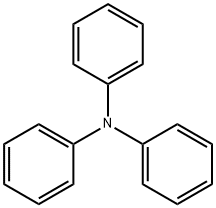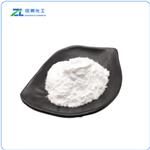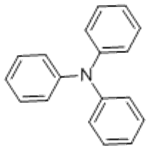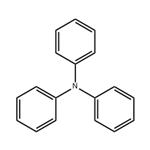Chemical Properties
Triphenylamine is a colorless crystalline solid.
Chemical Properties
Monoclinic crystals from EtOAc.
Uses
Organic light-emitting diode (OLED) devices have received much attention, because they are expected to be a next generation display and light source, thanks to lightweight and flexible organic materials.
- Triphenylamine is a propeller-like structural chromophore with a nitrogen atom center. The compound has a large steric hindrance and hyper conjugation electronic effect, which can enhance the stability of the nitrogen atomic radical. Triphenylamine materials also have a high hole mobility due to their unique free radicals nature. Many hole transport materials based on triphenylamine derivatives (TPD) are widely usable,because they are heat-resistant and amorphous.In addition to the TPDs, oxadiazole derivatives (PBD) having an electron transport property, Alq3 as a host material,and blue emissive distylyl derivatives are fundamental materials for amorphous OLED devices.
- It is used in the manufacture of photographic film.
- Triphenylamines (TPAs) are highly fluorescent compounds that are efficient to induce cell death upon visible light excitation.
- Triphenylamine is used in organic light-emitting diode as hole-transporters and as a pharmaceutical intermediate.
- It is coated on film bases as primary photoconductor.
Uses
Triphenylamine is used in organic light-emitting diode as hole-transporters and as a pharmaceutical intermediate. It is coated on film bases as primary photoconductor.
Uses
It is coated on photographic film,
where it acts as photoconductor.
Synthesis Reference(s)
Canadian Journal of Chemistry, 61, p. 86, 1983
DOI: 10.1139/v83-015Organic Syntheses, Coll. Vol. 1, p. 544, 1941
Air & Water Reactions
Insoluble in water.
Reactivity Profile
Triphenylamine neutralizes acids in exothermic reactions to form salts plus water. May be incompatible with isocyanates, halogenated organics, peroxides, phenols (acidic), epoxides, anhydrides, and acid halides. Flammable gaseous hydrogen may be generated in combination with strong reducing agents, such as hydrides.
Health Hazard
Triphenyl amine is considered
to have low systemic toxicity, but it may act as
a slight skin irritant.
Adverse effects have not been reported in
humans.
Fire Hazard
The flash point of Triphenylamine has not been determined, but Triphenylamine is probably combustible.
Safety Profile
Moderately toxic by
ingestion. When heated to decomposition it
emits toxic fumes of NOx. See also
AROMATIC AMINES.
Potential Exposure
Triphenylamine is used as a primary
photoconductor and in making photographic film coated on
photographic film bases.
Carcinogenicity
Triphenyl amine was not mutagenic in
bacterial assays with or without metabolic
activation.
Purification Methods
Crystallise the amine from EtOH or from *benzene/absolute EtOH, diethyl ether and pet ether. It is sublimed under vacuum and carefully dried in a vacuum line. Store it in the dark under nitrogen. [Beilstein 12 IV 276.]
Incompatibilities
Incompatible with oxidizers (chlorates,
nitrates, peroxides, permanganates, perchlorates, chlorine,
bromine, fluorine, etc.); contact may cause fires or explosions.
Keep away from alkaline materials, strong bases,
strong acids, oxo acids, epoxides, aldehydes, ketones.




